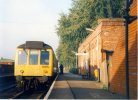BeijingDave
Member
- Joined
- 26 Jul 2019
- Messages
- 397
I was born in 1980 and remember we usually used to travel into Manchester Victoria from Warrington Bank Quay (with my mum to go shopping in the 'big city') in the 1980s, presumably because of the ease of access/car parking at Bank Quay compared to Central if coming from the south side of town.
However, I also remember going on a fast (possibly semi-fast) DMU from Warrington Central to Oxford Road occasionally. Does this seem possible or is my mind playing tricks on me?
What was the regular service pattern and units? I assume one Liverpool - Warrington stopper, one Warrington - Manchester stopper (as is the case now) on a 115, but is that correct? And what were the fast/semi-fast services? Were they also a 115 or were there loco-hauled services? As I recall, the loco-hauled trans-pennine were Llandudno-Newcastle (through Bank Quay).
However, I also remember going on a fast (possibly semi-fast) DMU from Warrington Central to Oxford Road occasionally. Does this seem possible or is my mind playing tricks on me?
What was the regular service pattern and units? I assume one Liverpool - Warrington stopper, one Warrington - Manchester stopper (as is the case now) on a 115, but is that correct? And what were the fast/semi-fast services? Were they also a 115 or were there loco-hauled services? As I recall, the loco-hauled trans-pennine were Llandudno-Newcastle (through Bank Quay).

